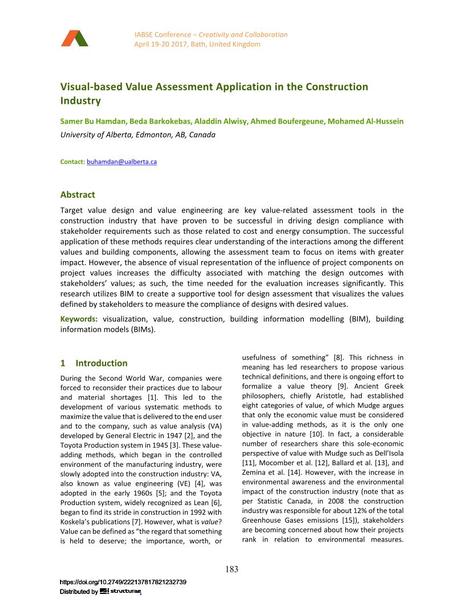Visual-based Value Assessment Application in the Construction Industry

|
|
|||||||||||
Détails bibliographiques
| Auteur(s): |
Samer Bu Hamdan
(University of Alberta, Edmonton, AB, Canada)
Beda Barkokebas (University of Alberta, Edmonton, AB, Canada) Aladdin Alwisy (University of Alberta, Edmonton, AB, Canada) Ahmed Boufergeune (University of Alberta, Edmonton, AB, Canada) Mohamed Al-Hussein (University of Alberta, Edmonton, AB, Canada) |
||||
|---|---|---|---|---|---|
| Médium: | papier de conférence | ||||
| Langue(s): | anglais | ||||
| Conférence: | IABSE Conference: Creativity and Collaboration – Instilling Imagination and Innovation in Structural Design, Bath, United Kingdom, 19-20 April 2017 | ||||
| Publié dans: | IABSE Conference Bath, April 19-20, 2017 | ||||
|
|||||
| Page(s): | 183-189 | ||||
| Nombre total de pages (du PDF): | 7 | ||||
| Année: | 2017 | ||||
| DOI: | 10.2749/222137817821232739 | ||||
| Abstrait: |
Target value design and value engineering are key value-related assessment tools in the construction industry that have proven to be successful in driving design compliance with stakeholder requirements such as those related to cost and energy consumption. The successful application of these methods requires clear understanding of the interactions among the different values and building components, allowing the assessment team to focus on items with greater impact. However, the absence of visual representation of the influence of project components on project values increases the difficulty associated with matching the design outcomes with stakeholders’ values; as such, the time needed for the evaluation increases significantly. This research utilizes BIM to create a supportive tool for design assessment that visualizes the values defined by stakeholders to measure the compliance of designs with desired values. |
||||
